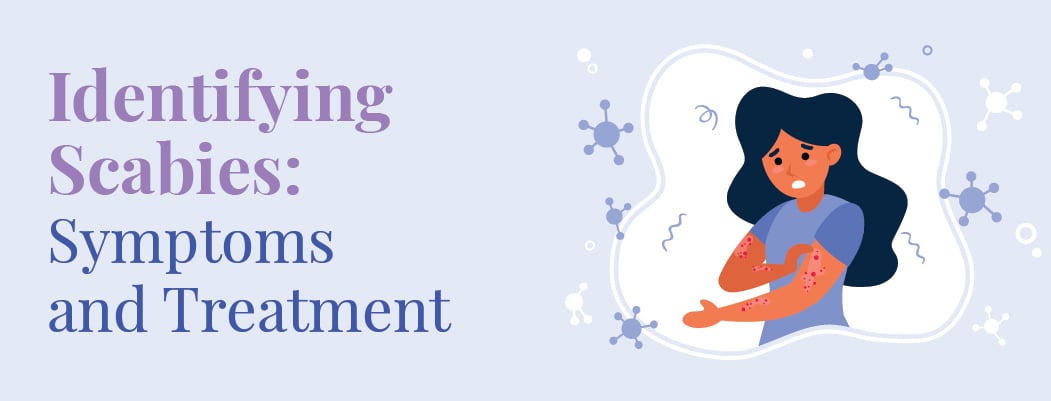How to identify scabies
February 23, 2023

Scabies is a skin infestation caused by a microscopic mite called Sarcoptes scabiei. The mites burrow into the skin and lay their eggs, causing a rash, intense itching, and irritation. Scabies is highly contagious and can be spread through skin-to-skin contact or by sharing bedding, clothing, or towels with someone with the condition.
Contents
Scabies cannot be seen by the naked eye and is identified by the rash it produces. The most common symptoms include an intense itching that worsens at night and a rash that appears as pink raised bumps with clear fluid-filled tops. These bumps may appear in a row and can also cause grey lines on the skin and red, scaly patches. While scabies can attack the entire body, it tends to affect the skin around the hands and feet. The appearance of scabies can be similar to rashes caused by other skin conditions such as dermatitis, syphilis, or other parasites like fleas.
Symptoms of Scabies
The symptoms of scabies can take up to six weeks to appear after exposure to the mites. However, in people who have had scabies before, the symptoms may appear within a few days. The symptoms of scabies include:
-
- Intense itching, especially at night
- A rash or red bumps on the skin
- Thin, wavy lines on the skin, especially between the fingers, on the wrists, elbows, armpits, or genitals
Sores caused by scratching
What causes scabies?
An infection of tiny, eight-legged mites leads to scabies. Although you can’t see these bugs on your skin because they are so small, their impacts are undeniable.
To survive and feed, the mites tunnel into the top layer of your epidermis. Mite females produce embryos. When the mites and their excrement contact your skin, a scarlet, itchy rash appears.
People can spread these mites readily. The most typical method of spreading the infestation is through direct skin-to-skin touch. Additionally, infested surfaces can disseminate the mites:
- furniture
- clothes
- bedding
Infestations frequently spread quickly in places where people reside close to one another. Nursing homes or other long-term care institutions may be among them.
Types of Scabies
Scabies is caused by a single type of mite called Sarcoptes scabiei, which can lead to several types of infestations.
- The most common form of scabies is typical scabies, which results in an itchy rash on the hands, wrists, and other common areas of the body but typically does not affect the face or scalp.
- Nodular scabies is another type that presents as raised bumps or lumps, especially in areas like the genitals, armpits, or groin.
- Crusted scabies, also known as Norwegian scabies, is a more severe and highly contagious form of scabies. It typically affects individuals with weakened immune systems, such as those living with HIV, undergoing chemotherapy, or taking certain medications. Crusted scabies results in thick, grey, crumbly crusts that contain thousands of mites and eggs, spreading in the same way as typical scabies.
How to Identify Scabies
Scabies is often diagnosed based on the characteristic symptoms described above. However, a definitive diagnosis can be made by examining a skin scraping under a microscope to look for the mites or their eggs.
Home Remedies for Scabies
Scabies can be treated with prescribed medications from an expert. However, some people prefer to try natural remedies before turning to prescription drugs. Here are some home remedies that may help alleviate the symptoms of scabies:
1.Tea tree oil: Tea tree oil has antiseptic, antifungal, and antiparasitic properties that can help kill the mites that cause scabies. Mix a few drops of tea tree oil with a carrier oil, such as coconut oil, and apply it to the affected areas.
2.Neem oil: Neem oil is a natural pesticide that can help kill the mites that cause scabies. Apply neem oil directly to the affected areas.
3.Clove oil: Clove oil has antiseptic and anti-inflammatory properties that can help alleviate the symptoms of scabies. Mix a few drops of clove oil with carrier oil, such as coconut oil, and apply it to the affected areas.
4.Aloe vera: Aloe vera has soothing and healing properties that can help alleviate the itching and inflammation caused by scabies. Apply fresh aloe vera gel to the affected areas.
5.Garlic: Garlic has antimicrobial and antifungal properties that can help kill the mites that cause scabies. Crush a few cloves of garlic, mix it with coconut oil, and apply it to the affected areas.
6.Turmeric: Turmeric is known for its medicinal properties and is commonly used in herbal and traditional medicine. It has been found to be effective in managing inflammation skin conditions. It may also be utilised as a home remedy for scabies by creating a paste from turmeric powder mixed with coconut oil or water and applying it to the affected areas. This home remedy has the potential to alleviate the symptoms of scabies.
7.Wash clothes in hot water: While not a cure for scabies, it is important to wash any clothing, bedding, or other fabric that has been in contact with an infected person’s skin in hot water. Doing so will eliminate any mites that may be hiding in the fabric and prevent the spread of scabies to other parts of the body or to other individuals.
8.Cayenne Pepper: Cayenne pepper is believed to be helpful in easing the pain and itching associated with scabies. Some people also think it has the ability to kill the scabies mite, although there is no scientific evidence to support this claim. The capsaicin present in cayenne pepper has a numbing effect on the skin’s nerves when applied topically. In a 2010 study, capsaicin cream was found to be effective in reducing chronic soft tissue pain after three weeks of use. Prior to use, it is recommended to perform a skin patch test.
Which doctor should you consult?
If a patient is suspected to have scabies, a dermatologist can usually make a diagnosis by conducting a thorough visual examination of their skin. To confirm the presence of scabies, the dermatologist may take a painless skin sample and examine it under a microscope on a glass slide.
People also ask
What are the early signs of scabies?
The early signs of scabies include intense itching, especially at night, and a rash or bumps on the skin that may look like tiny pimples or blisters. The rash usually appears on the hands, wrists, elbows, armpits, nipples, waist, buttocks, and genitals.
How can I check if I have scabies?
To check if you have scabies, you should look for the common signs and symptoms, including intense itching and a rash with small bumps or blisters on the skin in the areas mentioned above. You may also notice burrow marks or tracks on the skin, which look like tiny raised lines.








